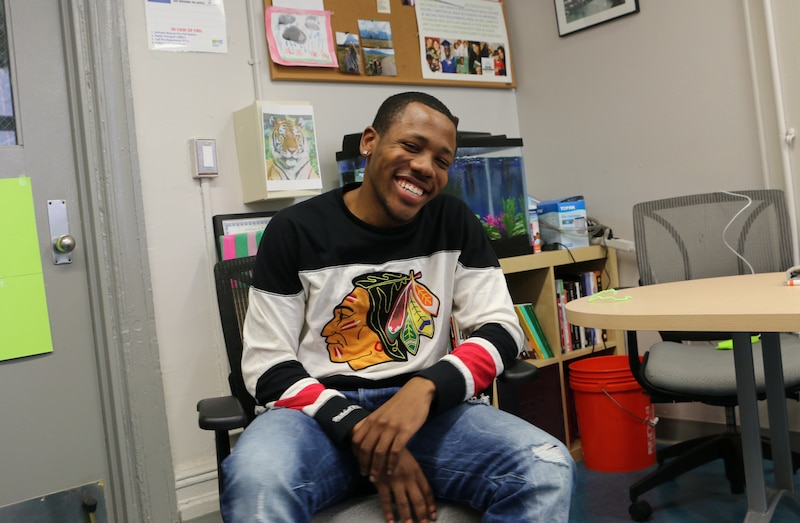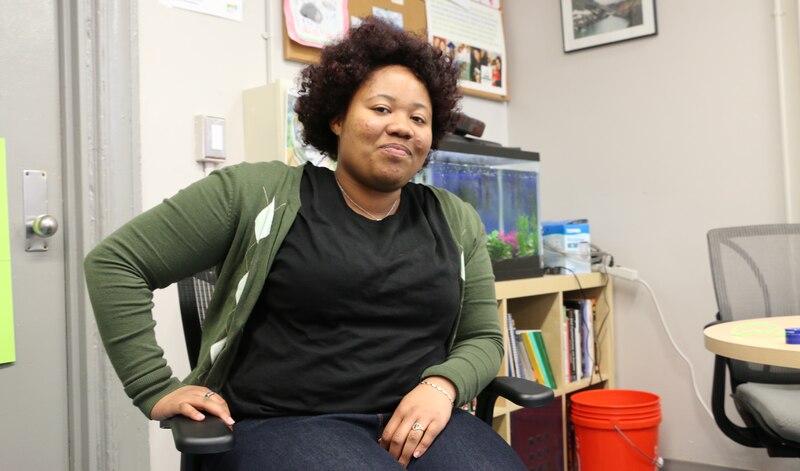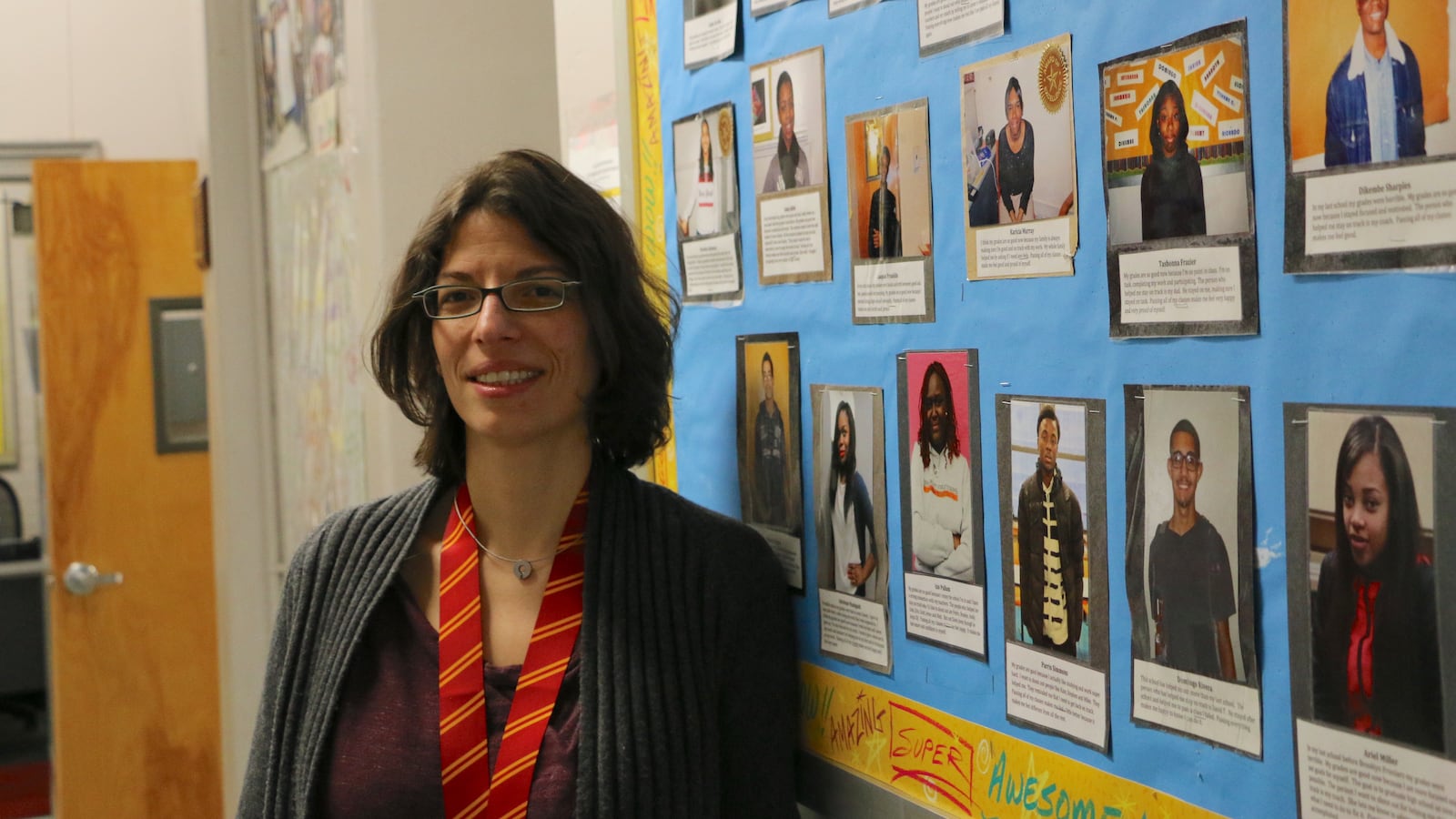The first-floor hallway at Brooklyn Frontiers High School is dominated by a “wall of fame” recognizing students who passed all of their classes last term. It’s a small group: Just 24 names are posted there, or less than 15 percent of the student body.
The school’s leaders aren’t fazed. Even a sliver of academic achievement is something to be celebrated at Brooklyn Frontiers, an oddity of the New York City school system where every student has previously been held back twice.
Many of the students got stuck in lower grades as they moved in and out of transitional housing or experienced family trauma that filtered into the classroom. Others have learning disabilities that went unaddressed for years. But they all have two things in common: Twice in their academic careers, someone told them they weren’t good enough. And by the time they reach ninth grade, they’re already 16.
“The level of trauma that our kids experience in their lives is at a level we were not prepared for,” said Principal Alona Cohen, who used to teach at a transfer school. “There are serious trust issues and worries about being judged.”
To serve those students, the school relies on small classes, a specialized coach for every student, and lots of teacher-to-teacher support. The school spends about $34,000 per student, compared with an average of nearly $21,000 citywide.
The stakes of the Brooklyn Frontiers experiment are high. The student body draws from underserved populations: Nearly all are black or Hispanic, 86 percent are economically disadvantaged, and almost half have disabilities. Some research shows that students who are held back just once are significantly less likely to graduate high school than their peers, and can even be linked to behavioral problems.
As the end of its fifth year approaches, the school is nearing an important milestone. The first four-year cohort had a graduation rate of just 29 percent, and school leaders are hoping that more students will earn a traditional high school diploma before they leave or age out of the system entirely.
Overcoming mistrust
When Cohen opened Brooklyn Frontiers in 2011, it became obvious that if the school were to succeed, it would need to dissolve students’ mistrust that was reinforced by years of negative experiences with the education system — and then find ways to rapidly get students up to par academically.
The school has sometimes struggled under the weight of its mission. Behavioral problems are common. After some students left their Regents exams largely blank, the school realized it had to revamp its math curriculum.
“At the beginning we were trying to understand to how to get kids to even do work,” Cohen said. “When our students come in, that’s the fight that we have to fight.”

The school has partnered with the non-profit Good Shepherd Services, which offers coaches who are assigned to each student and work in the school full time. They serve as a social-emotional resource for students and a crucial connection between the school and families.
After students filed out of Dave Donsky’s reading class on a recent afternoon, he explained that the coaches are a key part of the school’s success. As an example, he cited a student who had become so disruptive she had to be removed from his class.
“But through the process of meeting with the student and her coach we’re starting to form the bonds of trust,” Donsky said. “She’s learning to work with me and I’m learning to work with her.”
Another student, Jerrica Antwi, said her coach helped her stay on track after her father passed away. “We have coaches because people have a lot going on,” she said. Otherwise, “people can’t concentrate in class.”
Still, maintaining order can be challenging. Physical violence often spills into the school, and just a few weeks ago, a student was sent to the hospital after an altercation that involved a school safety officer.
Cohen called the incident an extreme, and says her discipline strategy is usually discussion-based — giving students, their coaches, and school leaders time to talk through what happened and how to prevent it in the future. But she’s also not afraid to suspend students.
“Sometimes the message doesn’t really get there until there is this big response,” she said.
Zeroing in on students’ specific needs is baked into the curriculum. Since every student is somehow behind, teachers focus on making sure students master foundational skills before moving on.
That philosophy is reflected in the school’s academic structure, which eschews a conventional grading system in favor of rubrics that define what skills students need to master, and what assignments will help get them there. The point is to ensure that students don’t miss important reading and math concepts, which they will need to pass Regents exams and graduate.
Brooklyn Frontiers’ approach was recently praised in an Advocates for Children report that featured the school’s literacy program. It “felt much more age appropriate than any other instruction we’ve seen for high schoolers who aren’t reading yet,” said Maggie Moroff, the organization’s special education policy coordinator. “There’s a lot of creativity that’s going on at the teaching level.”
Teachers are also finding ways to connect with students outside their regular classes, dissolving pent-up mistrust and boosting academic achievement all at once.
After struggling to reach a student who often slept through class and was among the school’s weakest readers, reading teacher Eric Wilson invited the student to hang out before school where they would read aloud together.
In hindsight, asking a student who had trouble staying awake to arrive extra early seems ridiculous, Wilson said. But the student showed up. Now, the club has attracted at least one other struggling reader.
“Reading was my toughest point,” said Kendell Jamison, one of the students who joined the morning reading club and also sometimes nodded off in class. “I had to find ways to get better at it – that was one.”
Is it working?
Since Brooklyn Frontiers opened, 23 students have earned diplomas. That’s just one-third of its first cohort, and far below city and state averages.

This year will be an important test, as a number of students in that first wave remain at the school. And while Cohen is more concerned with putting students on a path to graduation than with how long it takes them to get there, there is also a ticking clock: The school legally can’t continue to enroll students after the year in which they turn 21.
Later this year, the school will also get its first assessment under the de Blasio administration.
Even without that report, there are signs the school is struggling to meet all its students’ needs. Thirty-seven percent of its first four-year cohort have dropped out, state data show, though Cohen noted a handful of those students later enrolled or graduated from GED programs.
Rachel Forsyth, who helps oversee Good Shepherd’s partnerships with schools like Brooklyn Frontiers, says the school is doing good work that is difficult to quantify. If a student learns to read at the school, for example, but still struggles to graduate, should that count as a success?
“We have to find better ways of measuring that added-value growth,” she said. “When I think about the students who graduate, I think a million times yes, it’s working.”
There are other bright spots. Regents exam results have varied widely, but the school posted average pass rates of 50 percent or greater in each exam last year and virtually every student who took the Common Core ELA Regents exam earned a passing score.
“Any student who comes in the door, we should be able to get them to engage and move forward. Is that the case now? No,” Cohen said.
But she’s counting on being able to replicate the experience of students like Briana Alston, a 19-year-old who has struggled with math. She had largely rejected the idea that she could be happy at school, she explained earlier this month.
Now, Alston said, “No one’s making fun of you, the teachers let you take your time, they make it fun and make it comfortable.”
More importantly, she added, “I’m raising my hand.”

